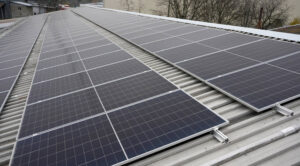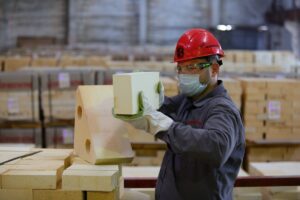
The EVA chain of stores has invested approximately UAH 100 million in improving the energy independence of its stores, logistics centers, and offices since 2022, purchasing nearly 1,200 generators and installing three rooftop solar power stations, according to the company’s press service.
The backup power system in stores is based on gasoline generators (1,133 units). The company keeps several dozen more generators in reserve to supplement the network or replace them in case of breakdowns. Uninterruptible power supplies based on EcoFlow and other similar systems are also provided. Stores located in shopping centers can obtain the necessary energy from the diesel-generating capacities of the shopping centers.
According to the press service, the share of cashless payments at EVA is over 50%, and the ability to pay for purchases by card even in the event of power outages and mobile communication interruptions is provided through fiber-optic internet. It is connected to store servers that exchange data with the company’s central server and bank POS terminals.
“In the absence of such a channel, a scheme has been implemented to work with data terminals that accumulate data and synchronize with the central server as soon as a connection is available. However, in this case, the use of loyalty program options is limited—bonuses are accrued but cannot be redeemed,” explains Viktor Sredniy, COO of the EVA store chain.
The company’s key distribution centers were provided with independent power supplies (powerful diesel generators) even before 2022. Currently, sufficient diesel fuel reserves have been made to ensure the operation of warehouses during stabilization/emergency shutdowns of the centralized power supply.
As an additional source of energy, solar power plants were installed at the company’s distribution centers in 2025: in Lviv (1,239 panels, 718 kW capacity), Dnipro (791 panels, 459 kW capacity), and Brovary (1,940 panels, 1,125 kW capacity).
According to Mykola Leonov, chief power engineer of the EVA and EVA.UA chain of stores, SES coverage ranges from 17% to 66% depending on the season and warehouse operating mode.
In connection with the expansion of the network and the increase in the company’s logistics capabilities, work continues in the direction of energy independence and energy efficiency. New stores are being equipped with generators on an ongoing basis. There are plans to install a rooftop solar power plant on a new warehouse building in Lviv and to purchase powerful diesel generators for backup power for this building and a new warehouse in Brovary. These facilities are scheduled to be commissioned in 2026.
“We are technically prepared for possible challenges. At the same time, the major risks for the business lie in the unpredictability of the scale and duration of power outages. We cannot maintain significant fuel reserves for each store, and since generators are now used by many companies across the country, simultaneous high demand could lead to a shortage of resources,” says Leonov.
Rush LLC, which operates the EVA chain, was founded in 2002. As of early 2025, the chain had 1,109 stores in operation.
According to YouControl, the owner of Rush LLC is listed as Cyprus-based Incetera Holdings Limited (100%), with Ruslana Shostak and Valeria Kiptika as the ultimate beneficiaries.
At the end of Q3 2025, Rush’s net income increased by 18.6% compared to the same period last year, to UAH 22.916 billion. Net profit decreased by 14.7% to UAH 1.7 billion.

Three cargo ships carrying more than 70,000 tons of wheat arrived at the port of Tartus in Syria as part of a program to strengthen strategic grain reserves and meet domestic market needs, local publication sana.sy reported, citing information from the port administration.
“Three ships loaded with more than 70,000 tons of wheat arrived at the port of Tartus for the General Directorate of Grain Trade and Processing as part of the government’s ongoing efforts to strengthen strategic grain reserves and meet the needs of the local wheat market,” the publication noted.
Yousef Arnous, the port’s operations manager, said that two ships brought grain from Ukraine and one from Russia, and they’re currently being unloaded. Part of the cargo will be stored in the port’s grain silos, while the rest will be transported by truck and rail to meet local market needs and ensure food security.
He added that a fourth ship with 26,000 tons of wheat is waiting to be unloaded, and there are signs that additional ships loaded with approximately 50,000 tons will arrive in the near future.
Nidal Abdel Kader, assistant director of the Tartus branch of the railway, said that one of the ships, called Golden Nour, arrived in Tartus with a cargo of more than 30,000 tons of wheat. Part of this cargo was delivered to the Ash-Shinshar elevators, and this is already the fourth delivery in the last period.
The publication recalled that on November 5, four ships carrying 94,000 tons of wheat arrived at the port of Tartus to replenish strategic reserves and meet the needs of mills in various provinces of Syria.

Argon Food, a company specializing in the production of bakery products and the storage and transportation of other food products, has installed a solar power plant with a peak capacity of 114 kW, according to Andriy Ocheretny, deputy mayor of Vinnytsia, on Facebook.
“A solar power plant with a peak capacity of 114 kW was installed on the roof of the enterprise. The station was put into operation at the end of May, and since then, thanks to its operation, the enterprise has covered almost all of its electricity needs,” he wrote on Facebook.
According to Ocheretny, the company has become one of the applicants for participation in the Procedure for partial compensation of expenses for the purchase of equipment used for the production of electricity from renewable energy sources within the city program.
“In the context of blackouts, the transition to ”green” energy is the path to energy independence. This strategic decision helps businesses reduce production costs, retain staff, and create new jobs, while contributing to the sustainable development of the community,” concluded the deputy mayor of Vinnytsia.

Citing Quiver Quantitative’s analysis, a number of publications reported that former Speaker of the U.S. House of Representatives Nancy Pelosi and her husband Paul Pelosi made more than $130 million in profits from stock transactions during her years in Congress. The New York Post estimates the combined profits to be about $130 million and the value of the portfolio at the end of 2025 to be about $133.7 million. These figures are not official financial statements and are based on aggregate estimates from public filings and market value of assets.
Investopedia estimates Pelosi’s wealth at more than $278 million at the end of 2025. At the same time, a significant portion of assets are linked to publicly traded shares of tech companies – Apple, Nvidia, Alphabet and others. Previously, OpenSecrets recorded that in some years Pelosi’s fortune fluctuated significantly depending on market conditions.
According to publications of the American media, Pelosi announced plans to complete her work in Congress at the end of the current term in January 2027.
The high profitability of Pelosi’s portfolio became the subject of public controversy and attempts to legally limit the transactions of members of Congress. Against this backdrop, services tracking politicians’ trades have gained popularity, as well as initiatives to ban or tighten trading rules for elected officials.

PJSC Zaporizhogneupor, Ukraine’s largest refractory manufacturer and a member of the Metinvest Group, reduced its net profit by 43.3% in January-September this year compared to the same period last year, from UAH 117.163 million to UAH 66.489 million.
According to the company’s interim report, the company increased its revenue by 20.5% over nine months, to UAH 3 billion 306.077 million.
Retained earnings at the end of September 2025 amounted to UAH 70.317 million.
Zaporizhogneupor is Ukraine’s largest manufacturer of high-quality refractory products and materials.
According to NDU data for the second quarter of 2025, Metinvest B.V. (Netherlands) owned 50.78% of Zaporizhogneupor’s shares, while Zaporizhstal owned 49.21%.
The authorized capital of the private joint-stock company is UAH 75.925 million.

In September 2025, EU countries adopted 79,205 new decisions to grant temporary protection to non-EU citizens who fled Ukraine as a result of Russian aggression, which is 49% more than in August 2025 and is the highest monthly average of new decisions recorded since August 2023.
“This increase came after the Ukrainian government adopted a decree at the end of August 2025 granting men aged 18 to 22 inclusive the right to leave Ukraine without hindrance,” Eurostat reported on its website on Monday.
According to its data, compared to the end of August 2025, the total number of people from Ukraine under temporary protection increased by 49,560 (+1.2%) to 4,302,160 at the end of September.
In its statistics for August, the agency reported a higher total figure of 4,373,460, but this included data from Portugal and Luxembourg, where there were 65,120 and 3,880 refugees from Ukraine with the corresponding status, respectively.
It is noted that in September, according to available data, the number of people under temporary protection increased in 24 EU countries. The largest absolute increase was recorded in Poland (+12,960; +1.3%), Germany (+7,585; +0.6%) and the Czech Republic (+3,455; +0.9%), while the only decrease was in France (-240; -0.4%).
According to Eurostat data, Germany remains the country with the largest number of refugees from Ukraine in the EU and the world – 1 million 218.1 thousand, or 28.3% of the total number of beneficiaries in the EU.
The top three also include Poland with 1 million 8,890, or 23.5%, and the Czech Republic with 389,310, or 9.0%. Spain with 244,170 and Romania with 192,840 follow with a significant gap.
Eurostat clarified that the data for Spain, Greece, and Cyprus includes some people whose temporary protection status is no longer valid.
According to the agency’s data, compared to the population of each EU member state, the highest number of temporary protection beneficiaries per thousand people at the end of September 2025 was observed in the Czech Republic (35.7), Poland (27.6), and Latvia (25.5), while the corresponding figure at the EU level is 9.6.
It is also noted that as of the end of September 2025, Ukrainian citizens accounted for more than 98.4% of temporary protection beneficiaries. Adult women accounted for 44% of temporary protection recipients in the EU, children for almost a third (31.0%), while adult men accounted for about a quarter (25.1%) of the total. A year earlier, women accounted for 45%, children for 32.3%, and adult men for 22.7%, while at the end of September 2023, adult women accounted for 46.5%, children for 33.7%, and adult men for 19.9%.
At the end of September 2025, there were also more than 100,000 people with temporary protection status in Slovakia (135,770), the Netherlands (130,500), and Ireland (116,350).
Between 50,000 and 100,000 were in Belgium (93,030), Austria (88,860), Norway (80,920), Finland (76,470), Bulgaria (73,200), Switzerland (70,520), and France (54,490) (data on children in France is mostly not included – Eurostat).
Next are Lithuania – 49.32 thousand, Sweden – 47.33 thousand, Denmark – 44.50 thousand, Hungary – 42.01 thousand, Greece – 37.41 thousand, Estonia – 34.96 thousand, Latvia – 31,150, Croatia – 27,840, Cyprus – 24,680, Iceland – 4,000 (data as of the end of February), Malta – 2,390, and Liechtenstein – 0,780.
Eurostat clarified that all data provided relates to the granting of temporary protection on the basis of EU Council Decision 2022/382 of March 4, 2022, which establishes the existence of a mass influx of displaced persons from Ukraine in connection with Russia’s military invasion and entails the introduction of temporary protection. On June 25, 2024, the European Council decided to extend temporary protection for these persons from March 4, 2026, to March 4, 2027.
According to updated UNHCR data, the number of Ukrainian refugees in Europe as of October 3, 2025, was estimated at 5.192 million (5.138 million as of September 2), and 5.753 million (5.696 million) worldwide.
In Ukraine itself, according to the latest UN data for July this year, there are 3.340 million internally displaced persons (IDPs), compared to 3.757 million in April.
As Serhiy Sobolev, then Deputy Minister of Economy, noted in early March 2023, the return of every 100,000 Ukrainians home results in a 0.5% increase in GDP.
In its July inflation report, the National Bank of Ukraine worsened its migration forecast: while in April it expected a net inflow of 0.2 million people to Ukraine in 2026, it now forecasts a net outflow of 0.2 million, which corresponds to the estimate of the net outflow this year.
“Net return will only begin in 2027 (about 0.1 million people, compared to 0.5 million in the previous forecast),” the NBU added, confirming this forecast at the end of October.
In absolute terms, the National Bank estimates the number of migrants currently remaining abroad at about 5.8 million.
Source: http://relocation.com.ua/in-september-the-eu-accepted-almost-80000-refugees-from-ukraine/